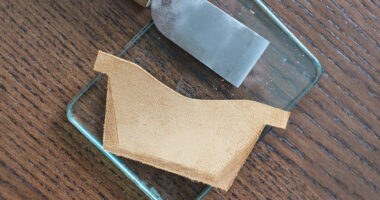Pricking irons are one of the most expensive hand tools in leather crafting but with so many brands and multiple different sizes, how to choose?
The most common sizes for pricking irons are 2.7mm, 3.0mm, 3.38mm, 3.85mm. The type of leather goods you intend to make will determine the best size. High-end watch straps? 2.7mm. Wallets and card holders? 2.7mm to 3.38mm. Larger accessories? Maybe 3.38mm or 3.85mm. But if you’re reading this article there’s a good chance you don’t own any pricking irons and want to try your hand at a variety of goods. If so, we would recommend 3.38mm or 3.85mm. Smaller pricking irons are more difficult to use and less versatile. 2.7mm stitching on a small handbag probably would look a little odd.
The bigger question is which brand? Should you open up the wallet and purchase from one of the high-end brands like Vergez Blanchard, KS Blades, or Sinabroks? Go for something mid-range from a company like WUTA? Or opt for one of the many cheaper, generic, Chinese-made irons? Does it really make much of a difference? After all, aren’t we just punching through leather?
Firstly, the same size pricking iron does not necessarily produce the same stitch look. It is important to be aware of the width of the tooth itself, as well. A 3.38mm pricking iron from KS Blades, for example, has 1.8mm wide teeth. The same size pricking iron from Sinabroks will be 2.2mm in width. It might not sound like much, but this fraction of a millimeter means you can use a slightly bigger thread size while keeping things looking pretty and the final stitching will have a slightly more pronounced slant.
Secondly, like just about anything, you’re paying for quality. This isn’t just in terms of iron longevity and teeth sharpness retention but also in terms of knowing that if you buy a 3.38mm pricking iron, those teeth will measure exactly 3.38mm in distance from each other. This is particularly critical if you are creating designs using vector software such as Adobe Illustrator and dimensioning products based on the size of the pricking iron to be used.
Another consideration is whether the teeth are replaceable? Pricking irons from WUTA and Amy Roke, for example, are one solid piece of metal. If a tooth breaks then the only option is to replace the iron. Pricking irons from KS Blades and Sinabroks, on the other hand, have teeth that can be individually replaced. Admittedly, so long as you’re using the irons the correct way and punching on a dedicated punching block, the teeth should last a long time, but it’s good to know there is the option to replace.
Beyond that, it comes down to the feel of the iron in your hand, the sharpness of the teeth, and, of course, cost.
